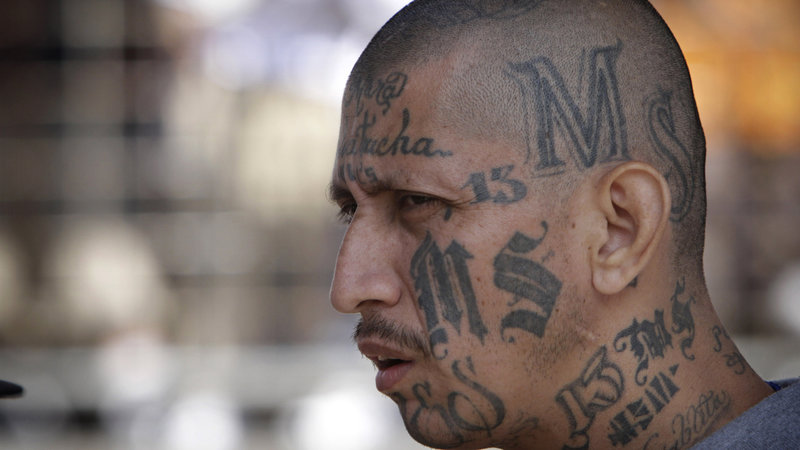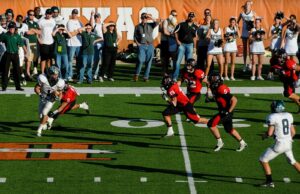Los Angeles is well-known for its major attractions such as Disneyland, Sea World, Universal Studios, and its many other attractions. Los Angeles is one of the most popular cities in the world. Of course, when people think of the city, they think of a very lavish lifestyle full of celebrities and famous Hollywood movies, but little do people know that there exists a whole different world in the southern part of the city. South-Central Los Angeles is known for its crime and gangs. The Bloods, which was a very big gang in Los Angeles, had already been formed and they were committing crimes throughout their neighborhoods in southern Los Angeles, much like their rival gang, the Crips. There was another gang known as the Barrio 18 (18th Street Gang), which was the largest gang not only in Los Angeles, but also in the country in the 1970s and 1980s. Though Los Angeles was the second largest Mexican population city in the world, it was also made up of numerous immigrant groups from Latin America beyond Mexico, and because of that, it was also the birthplace of the most dangerous and largest street gang in the world.
During the 1980s, the Central-American country of El Salvador was experiencing a very serious war between the government and its people. The army, loyal to the government, tried to recruit many young men to join with them, but many refused. With the war becoming more intense by the day, many people who were revolting against the government were being attacked. Since the government at the time was under a dictatorship, many of the young men were forced to join the government army. The recruiters would show up randomly at the schools. It did not matter if they were from high school, middle school, or elementary school, the government wanted young soldiers on their side. The recruiters took the young boys without giving warning to their families, and immediately trained them for war. Sometimes, when the army knew that some of these boys were against the government, they would simply kill them on the spot. Therefore, in fear of being drafted in this way, hundreds of thousands of Salvadorans fled to the United States.1 Most of the families who arrived in the United States had no idea where to go, because they did not have family members in the United States at that time. The immigrants spread throughout the southern United States, but the majority of the immigrants settled in various neighborhoods of Los Angeles. Within the city of Los Angeles, there were many longstanding gangs, such as Barrio 18, which mostly consisted of Mexican Americans, and there were also Asian gangs and African-American gangs. There was one particular neighborhood known as Pico Union, and it would become the birth place of one of the most notorious gangs of all time, based on the immigration of Salvadoran youths fleeing the violence of their homeland: MS-13.

The Pico Union neighborhood was originally home to a gang called the Barrio 18, or simply Street Gang 18. Before MS-13 came along, Barrio 18 was known as the most dangerous gang in America. At the time, Barrio 18 had a large number of members all over the United Sates, and some members resided in parts of Mexico or in Central America. Barrio 18 had become the most powerful gang in Los Angeles because of its violent acts and illegal business. Unlike MS-13, Barrio 18 was very well organized.2 Like any other gang, they were known for violence, illegal trading of narcotics, and prostitution, but they were constantly growing, especially since there were so many different groups of Latinos living in Los Angeles. But, all of that changed when the Salvadorans came into the picture.
Mexicans often harbor racist attitudes towards Salvadorans, and it was no surprise when tensions started rising between the two groups in the Pico Union district. There were many times when the two groups would start fights and would get in trouble with the authorities, which result in deportations, since many of the members were undocumented. Though most fights were physical, some of them resulted in many people getting seriously injured and sometimes killed. It was very common for many gangs to bring weapons with them for a fight, but since the Salvadorans were still ignorant to the ways of a gang, they were always unprotected.3
As time went by and the two gangs started to get into more conflicts, the need to fight back grew stronger among the Salvadorans. It is believed that the way MS-13 started came from a soccer match on the playground of Seoul International Park in the Pico-Union neighborhood of Los Angeles.4 Soccer is a very popular sport among Hispanics; therefore, it was not surprising to see the two groups play against each other. The Salvadorans and Mexicans were playing against each other when all of a sudden, a fight broke out that resulted in the Salvadorans being outnumbered once again. After that night, a group of young Salvadorans decided to get together and form what is now known as MS-13. The group swore to always protect their “barrio” or “hood.” From then on, MS-13 would expand to have around 700,000 members in many parts of the world.5

The gang started evolving and was soon starting to catch on to the gang lifestyle. Instead of guns, gang members would often carry a machete with them wherever they went. The machete was not only for protection, but it was also a way for the members to kill someone. The machete was also a common weapon for many Salvadorans to carry around with them back in El Salvador. One member of MS-13 would recall, “guarding the family’s crops at the age of 4, armed with a machete, alone at night.”6 Many times, their victims would suffer several cuts around their body or, in severe cases, some of their body parts would be completely cut off. As one officer recalled, he found a body, “on the banks of the Shenandoah River, repeatedly stabbed and her head nearly severed.”7
MS-13 consisted of many undocumented Salvadoran immigrants, but when the members started to get deported, they would go back to their country and spread the awareness of the newfound gang. Another distinct characteristic that the gang has is that the members of the gang usually have tattoos that use “the emblem MS-13” across their forehead, torso, or their back.8 Another common tattoo would be the devil’s hand with the MS-13 emblem. It was very easy to spot who the members of the gang were, let alone their mass number of members. The members of MS-13 would wear white shirts, maybe a flannel over it, large shorts that would often sag, and Cortez’s along with white socks. The gang adapted into a “cholo” like attire all while expanding their connections and creating a massive empire all throughout the 1980s. MS-13 grew more and they started having outposts all over El Salvador, Honduras, Nicaragua, and sometimes they would even recruit Mexicans. But, as the power and population increased, so did the tensions between them and Barrio 18.

As mentioned before, the Barrio 18 was mostly Mexican American, and Mexicans at that time were racist towards the Salvadorans. But, when MS-13 started growing and getting more dangerous, Barrio 18 could not help but notice what an empire the MS-13 had built. With both MS-13 controlling Pico-Union’s flourishing drug trafficking market, violence rose to a new level.9 A big reason why MS-13 became so famous was because of their distinct rivalry with Barrio 18. Since both groups had many members spread throughout the United States and many countries throughout Central America, they made many places very dangerous. For example, the city of San Pedro Sula in Honduras became one of the most dangerous countries in the world due to the gang violence between MS-13 and Barrio 18. Both gangs, “fight each other for control of territory so that they can expand their extortion rackets, trade in drugs and engage in other forms of organized crime. But gang members also murder their rivals simply to raise their status within their own gang, which helps perpetuate the conflict.”10
The way MS-13 operates is quite unique and is another aspect of what makes them unique. As one former member would say, “First is God, then your mother, then your gang. You live for God, you live for your mother, you die for your gang.”11 The gang seemed to be very family oriented, so they would recruit new members just as long as the new recruits would promise to stay loyal to them no matter what. If someone were to be discovered going behind the gang’s back or having relations with other gangs, then they would be killed without hesitation. For example, one member had turned to the government. Therefore, three MS-13 members—close friends of Paz— were “tapped” by the gang’s leadership to carry out her murder.12 MS-13 was very big on loyalty and being like a family, so there was no dictatorship that would keep the gang together, which also made them very difficult to take down by the authorities because they could not identify who the leader was. As many people would say, “It’s considered the fastest-growing, most violent and least understood of the nation’s street gangs.”13
Today, MS-13 has created a very large empire, spreading not only across the United States, but also throughout the world. The FBI has named MS-13 as the most dangerous gang and though there have been many efforts to stop their expansion, the gang seems to be almost impossible to stop.
- Kelly Padgett Lineberger, “Vanderbilt Journal of Transnational Law Note The United States – El Salvador Extradition Treaty: A Dated Obstacle in the Transnational War against Mara Salvatrucha (MS-13), ”Vanderbilt Journal of Transnational Law 44, no.1 (2011): 190-191. ↵
- Ana Arana, “How the Street Gangs Took Central America,” Foreign Affairs 84, no. 3 (2005): 102. Accessed February 28, 2020. doi:10.2307/20034353. ↵
- Arian Campo-Flores et al., “The Most Dangerous Gang in America,” Newsweek, 2005, 145 (13): 22–25. http://search.ebscohost.com/login.aspx?direct=true&db=a9h&AN=16479562&site=eds-live&scope=site. ↵
- Kelly Padgett Lineberger, “Vanderbilt Journal of Transnational Law Note The United States – El Salvador Extradition Treaty: A Dated Obstacle in the Transnational War against Mara Salvatrucha (MS-13).”Vanderbilt Journal of Transnational Law 44, no.1 (2011): 190-191. ↵
- Arian Campo-Flores et al., “The Most Dangerous Gang in America,” Newsweek, 2005, 145 (13): 22–25. http://search.ebscohost.com/login.aspx?direct=true&db=a9h&AN=16479562&site=eds-live&scope=site. ↵
- Arian Campo-Flores et al., “The Most Dangerous Gang in America,” Newsweek, 2005, 145 (13): 22–25. ↵
- Arian Campo-Flores et al., “The Most Dangerous Gang in America,” Newsweek, 2005, 145 (13): 22–25. ↵
- Charles Legge, “Tattoo That’s Sign of Terror,” Daily Mail, January 26, 2018. ↵
- Kelly Padgett Lineberger, “Vanderbilt Journal of Transnational Law Note The United States – El Salvador Extradition Treaty: A Dated Obstacle in the Transnational War against Mara Salvatrucha (MS-13),” Vanderbilt Journal of Transnational Law 44, no.1 (2011): 190-191. ↵
- Ioan Grillo, “The Kill Zone,” TIME Magazine, 2015, 186 (5): 42. ↵
- Kelly Padgett Lineberger, “Vanderbilt Journal of Transnational Law Note The United States – El Salvador Extradition Treaty: A Dated Obstacle in the Transnational War against Mara Salvatrucha (MS-13),” Vanderbilt Journal of Transnational Law 44, no.1 (2011): 190-191. ↵
- Kelly Padgett Lineberger, “Vanderbilt Journal of Transnational Law Note The United States – El Salvador Extradition Treaty: A Dated Obstacle in the Transnational War against Mara Salvatrucha (MS-13),” Vanderbilt Journal of Transnational Law 44, no.1 (2011): 190-191. ↵
- Arian Campo-Flores, et al., “The Most Dangerous Gang in America,” Newsweek, 2005, 145 (13): 22–25. ↵



75 comments
Hali Garcia
Great article!!! I learned a little bit about gangs in my criminal justice class when I was in high school so I am somewhat familiar with MS-13. I knew that they were rivals to Barrio 18, but I did not know how they were created. What struck me was that their weapon of choice was the machete instead of a gun. I was familiar that they do have their own tattoos that you can identify them by.
Thiffany Yeupell
I am impressed at how extensive the MS-13 network is and how difficult it is to uproot and keep the gang conflicts and crimes low. I was aware of the presence of MS-13 a couple of years ago but did to know about the rival gang, Barrio 18. I can imagine this attest to how dangerous MS-13 is, but was truly a major factor that propelled the existence and power of the gang. Yet I did enjoy the background and reason for the start of MS-13, as the war in El Salvador was a contributing factor. Nothing in this world is ever truly in a bubble by itself, and one way or another, it will find a connection, not another event.
Kendall Guajardo
I learned so much new information from this article. I knew gangs had rivalries but the logistics of MS-13’s come up was something I did not know. Just from the differences in choice of weapons makes the gang seem more volatile than the Barrios. There has been a longstanding stereotype of Los Angeles being a dream city but there is this hidden life that many people are not aware of. I also did not know that Mexicans harbored racism against the Salvadorians. It is really unfortunate that they become deported and spread the MS-13 more across the country especially because of all the existing violence already.
David Castaneda Picon
This is a great story, and I think its true that when we think of Los Angeles we think of the city as just glamorous and popular city, but it is true that there is also crime in that city. I have never heard much about the Mara Salvatrucha gang, I would never thought that they originated in Los Angeles and that the gan was formed by people from el Salvador. I think it is incredible how an organization like MS-13 or Barrio 18th can gain so much power and build an empire that fast.
Yuliana Vasquez
This was a very unique story, it kept me interested the whole way. Yes I have always heard about gang being dangerous but the fact that you went into detail about how it all started made me really understand why these type of things start. Its crazy how these young innocent kids have to go through that, instead of letting them get a good education, they would train them to become heartless killers for the army which is really sad.
Davis Nickle
This is really an incredible story. To think that the group that many people would consider to be the most deadly gang in America had such a seemingly innocent begging. I was shocked to find out that many of the founding members were refugees from a tyrannical regime and were simply trying to stick together to keep each other safe, and thus made a gang. I bet no one at the time suspected that they would grow to hold the power that they do today.
Melissa Garza
When I think of Los Angeles I have never put thought into this side of the glamorous city. It was really interesting to read about the MS-13 gang because honestly I have never heard of it. For a long time here in the valley, I had only ever heard of the TCB (Texas City Bombers) and their gruesome acts. It is horrific to think of the crimes MS-13 has committed and scary to think about how spread out they are in the world.
Andrea Degollado
I actually found this article very interesting. I ad previously done some research on Hispanic and Latin American history and MS-13 was a very big part in that history. I think that for many people that didn’t know who MS-13 was, this article does a very good job in informing the reader on their history. Very well written article. Good job!
Nelly Perez
There were some things that I did not know much about El Salvador’s history. It saddened me a bit that young boys in elementary were forced to join the army along with middle school kids and high school kids. I know most people flee their country because they were afraid of what happened in their country such as forced entry into the army and if you were against them, you’d be killed.
Estefanie Santiago Roman
It was very interesting to read about the gang MS-13, I hadn’t really heard about them, I am more familiar with Cartels. I didn’t know anything about them to begin with but it was interesting to read about their origin of the gang. I didn’t know that most members came from El Salvador, and I found their loyalty for the gang and for their families quite amazing. I was amazed by the fact that authorities were not able to find a specific leader which makes me wonder if all the members took the decisions unanimously and whether the gang had a specific goal.